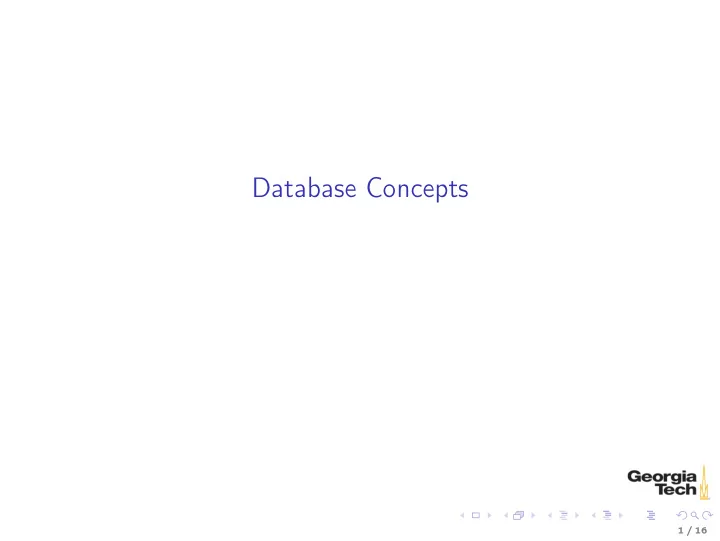

Database Concepts 1 / 16
Database Concepts ◮ Data models, schemas, instances ◮ Three-schema architecture and data independence ◮ Database languages and interfaces ◮ Database systems ◮ DBMS Architectures ◮ Classification of DBMSes 2 / 16
Data Models ◮ Abstraction: suppression of details ◮ Essential attributes of an entity for a particular application ("selective ignorance") ◮ Data model: collection of concepts describing a database ◮ Structure of database: entities, attributes, data types, relationships ◮ Operations on the data: updates and retrievals 3 / 16
Categories of Data Models ◮ High level conceptual, e.g., (E)ER ◮ The end users’ conception of their data, understood by end users and database developers ◮ A tool for understanding user data in enough detail to derive an implementaion model from it ◮ Representational (implementation), e.g., Relational ◮ Understood by database developers ◮ Rigorous, mechanically translatable to physical model ◮ Low-level physical ◮ How data are stored on disk (the code inside a DBMS) 4 / 16
Conceptual Data Model: Entity-Relationship ◮ Entity: a real world object or concept that will be modeled in the database ◮ Attribute: a property of interest of some entity ◮ Relationship: an association between two or more entities 5 / 16
Representational (Implementation) Models ◮ Most common: relational data model (focus of this class) ◮ Others: ◮ Legacy: network, hierarchical ◮ Object data models: never gained widespread adoption ◮ Self-describing: XML, JSON (e.g., MongoDB) - a.k.a. NOSQL (Not Only SQL) ◮ Graph models: major emphasis today, e.g., social networks 6 / 16
Schemas and Databases ◮ A schema is a description of the data in a database (metadata), typically depicted in a schema diagram ◮ Constructs, e.g., STUDENT, COURSE, that specify elemets of the data model ◮ Constraints, e.g., STUDENT.GTID must be unique ◮ Database state is set of instances of entities specified in the schema ◮ As data loaded into databse, DBMS ensures valid states by ensuring data instances conform to schema and meet constraints ◮ Sometimes schema called intension, state called extension 7 / 16
Three-Schema Architecure Three layers of abstraction: ◮ External level: external schemas, a.k.a. "views" ◮ An external schema also representational, but tailored to particular (class of) user(s) ◮ Conceptual level: conceptual schema ◮ Conceptual schema corresponds to representational (implementation) model, not conceptual model ◮ Internal level: internal schema – physical storage structures Transformations of data between levels is called mapping; may be computationally expensive Note: be careful not to confuse categories of data models with levels of abstraction in the three-schema architecture. 8 / 16
Three Schema Diagram 9 / 16
Data Independence ◮ Goal of Three-Schema Architecure is to separate user applications from physical database. We call this data independence: isolation of changes at one level from levels above ◮ Logical data independence: changes to the conceptual schema don’t requre changes to external schemas ◮ Mappings, e.g., view definitions, may need to change ◮ Physical data independence: changes to internal schema don’t require changes to conceptual schema 10 / 16
Database Languages ◮ Data definition language (DDL) specifies conceptual and internal schemas ◮ Some systems have a seaprate storage definition language (SDL) to specify internal schemas ◮ View definition language (VDL) specifies user views (external schema) ◮ Data manipulation language (DML) used to insert, retrieve, update, and delete data from database Modern DBMS systems don’t have distinct languages. ◮ SQL combines DDL, VDL, and DML 11 / 16
Database System Architectures ◮ Centralized ◮ Client/Server ◮ Three-tier and n-tier 12 / 16
Centralized Database Architecture 13 / 16
Client/Server Database Architecture Also known as "two-tier." 14 / 16
Three-tier and n-tier Database Architecture 15 / 16
DBMS Classification Criteria ◮ Type of data model supported ◮ relational, key-value, document-based, graph-based ◮ Number of users supported – single user vs. multi-user ◮ Number of sites ◮ Centralized vs. distributed ◮ Homogeneous, heterogeneous ◮ middleware ◮ federated multi-database systems ◮ Cost 16 / 16
Recommend
More recommend